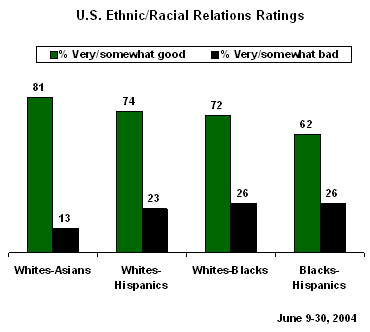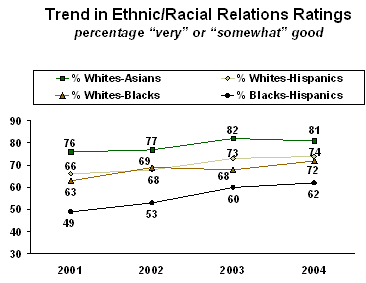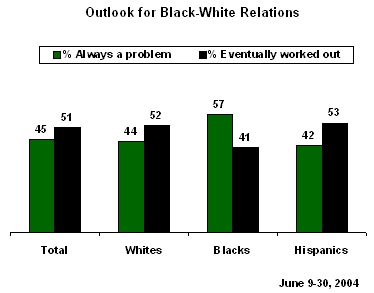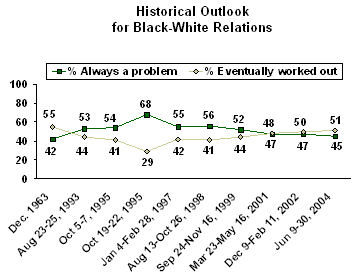GALLUP NEWS SERVICE
PRINCETON, NJ -- Gallup's annual Minority Rights and Relations survey, conducted June 9-30, finds that the American public has mostly positive perceptions of relations between blacks and whites, as well as between other racial and ethnic groups in the country today. Specifically, 72% of Americans think relations between whites and blacks are either "very" or "somewhat" good; only 26% say they are "very" or "somewhat" bad. White-Hispanic relations receive a similar review, while white-Asian relations are rated slightly better and black-Hispanic relations are rated slightly worse.

Ratings for each of the four racial/ethnic pairs measured are more positive than results from Gallup's first polling on this in 2001. The perceptions of black-Hispanic relations have shown the greatest improvement, with a 13-point increase in the percentage calling relations very or somewhat good -- from 49% in 2001 to 62% today. There has been a nine-point increase in positive ratings of white-black relations (from 63% to 72%), and an eight-point increase in positive ratings of white-Hispanic relations (66% to 74%). There has been a five-point increase in positive ratings of white-Asian relations (76% to 81%), but this is not a statistically significant change.

The latest survey includes large oversamples of blacks and Hispanics that allow for statistically reliable analysis of their views, in addition to the views of non-Hispanic whites (hereafter referred to as whites). Whites, blacks, and Hispanics all have generally positive evaluations of relations between each group. However, there are some notable differences in their ratings.
- Whites have more positive perceptions of white-black relations than do blacks or Hispanics. Three-quarters of whites (74%) consider white-black relations good, versus 68% of blacks and 61% of Hispanics.
|
White-Black Relations |
||||
|
|
Total |
Non-Hispanic Whites |
Blacks |
Hispanics |
|
|
% |
% |
% |
% |
|
Good |
72 |
74 |
68 |
61 |
|
Bad |
26 |
25 |
29 |
31 |
|
|
|
|
|
|
|
Net Positive |
46 |
49 |
39 |
30 |
- Whites and Hispanics share a more positive perception of white-Hispanic relations, compared with blacks. Seventy-four percent of whites and 76% of Hispanics, compared with 62% of blacks, believe white-Hispanic relations are good.
|
White-Hispanic Relations |
||||
|
|
Total |
Non-Hispanic Whites |
Blacks |
Hispanics |
|
|
% |
% |
% |
% |
|
Good |
74 |
74 |
62 |
76 |
|
Bad |
23 |
24 |
26 |
19 |
|
|
|
|
|
|
|
Net Positive |
51 |
50 |
36 |
57 |
- Whites have a much more positive perception of white-Asian relations than do either blacks or Hispanics. Only 68% of blacks and 72% of Hispanics believe white-Asian relations are good, versus 84% of whites.
|
White-Asian Relations |
||||
|
|
Total |
Non-Hispanic Whites |
Blacks |
Hispanics |
|
|
% |
% |
% |
% |
|
Good |
81 |
84 |
68 |
72 |
|
Bad |
13 |
13 |
17 |
13 |
|
|
|
|
|
|
|
Net Positive |
68 |
71 |
51 |
59 |
- Blacks overwhelmingly perceive black-Hispanic relations to be good, while Hispanics are a bit more negative, and whites are even more negative. Only 58% of whites and 68% of Hispanics, compared with 77% of blacks, think black-Hispanic relations are good.
|
Black-Hispanic Relations |
||||
|
|
Total |
Non-Hispanic Whites |
Blacks |
Hispanics |
|
|
% |
% |
% |
% |
|
Good |
62 |
58 |
77 |
68 |
|
Bad |
26 |
27 |
17 |
25 |
|
|
|
|
|
|
|
Net Positive |
36 |
31 |
60 |
43 |
In fact, the "net positive" gap between blacks and Hispanics in their assessment of relations between their two groups is the widest of any interracial/ethnic pairing measured in the survey:
- Blacks' rating of black-Hispanic relations: 60 percentage points net positive
- Hispanics' rating of black-Hispanic relations: 43 percentage points net positive
- "Net positive gap": 17 percentage points
By comparison, the net positive gap between whites and blacks in their ratings of white-black relations is 10 points (49% among whites, 39% among blacks). There is only a seven-point gap (50% among whites, 57% among Hispanics) between whites and Hispanics in their ratings of white-Hispanic relations.
A Different Question, a Different Finding
Contrasted with these generally upbeat results about the state of race relations in the country, a different question pre-supposing problems exist between whites and blacks finds a majority of blacks pessimistic that the problems between the two races will ever be worked out. Whites, on the other hand, are slightly more optimistic.
When asked, "Do you think that relations between blacks and whites will always be a problem for the United States, or that a solution will eventually be worked out?", 57% of blacks say relations will always be a problem, compared with 44% of whites and 42% of Hispanics who feel this way. A slim majority of whites and Hispanics are optimistic that the problems will be worked out.

The long-term trend on this question shows that Americans were most optimistic about resolving black-white tensions at the time the question was initiated in 1963. Attitudes were noticeably negative during much of the 1990s -- a decade marked by the Rodney King incident, the Los Angeles riots, and O.J. Simpson murder trial -- but have been more evenly split since 2001.

Survey Methods
Results are based on telephone interviews with 2,250 national adults, aged 18 and older, conducted June 9-30, 2004, including oversamples of blacks and Hispanics that are weighted to reflect their proportions in the general population. For results based on the total sample of national adults, one can say with 95% confidence that the maximum margin of sampling error is ±5 percentage points.
Results for the sample of 816 non-Hispanic whites, aged 18 and older, are based on telephone interviews conducted June 9-30, 2004. For results based on this sample, one can say with 95% confidence that the maximum margin of sampling error is ±6 percentage points.
Results for the sample of 801 blacks, aged 18 and older, are based on telephone interviews conducted June 9-30, 2004. For results based on this sample, one can say with 95% confidence that the maximum margin of sampling error is ±8 percentage points.
Results for the sample of 503 Hispanics, aged 18 and older, are based on telephone interviews conducted June 9-30, 2004. For results based on this sample, one can say with 95% confidence that the maximum margin of sampling error is ±8 percentage points. (164 out of the 503 interviews with Hispanics were conducted in Spanish.)
In addition to sampling error, question wording and practical difficulties in conducting surveys can introduce error or bias into the findings of public opinion polls.
11. Next, we'd like to know how you would rate relations between various groups in the United States these days. Would you say relations between -- [RANDOM ORDER] -- are very good, somewhat good, somewhat bad, or very bad?
A. Whites and blacks
|
|
Very |
Somewhat good |
Somewhat bad |
Very |
No |
|
Total |
% |
% |
% |
% |
% |
|
2004 Jun 9-30 |
13 |
59 |
20 |
6 |
2 |
|
2003 Jun 12-18 |
10 |
58 |
24 |
6 |
2 |
|
2002 Jun 3-9 |
8 |
61 |
23 |
5 |
3 |
|
2001 Jun 11-17 |
6 |
57 |
28 |
7 |
2 |
|
|
|
|
|
|
|
|
Non-Hispanic Whites |
|
|
|
|
|
|
2004 Jun 9-30 |
13 |
61 |
20 |
5 |
1 |
|
2003 Jun 12-15 |
10 |
59 |
25 |
5 |
1 |
|
2002 Jun 3-6 |
7 |
63 |
24 |
3 |
3 |
|
2001 Jun 11-17 |
6 |
56 |
30 |
6 |
2 |
|
|
|
|
|
|
|
|
Blacks |
|
|
|
|
|
|
2004 Jun 9-30 |
12 |
56 |
21 |
8 |
3 |
|
2003 Jun 12-18 |
9 |
50 |
26 |
13 |
2 |
|
2002 Jun 3-9 |
9 |
59 |
18 |
13 |
1 |
|
2001 Jun 11-17 |
8 |
62 |
17 |
11 |
2 |
|
|
|
|
|
|
|
|
Hispanics |
|
|
|
|
|
|
2004 Jun 9-30 |
12 |
49 |
21 |
10 |
8 |
|
2003 Jun 12-18 |
11 |
57 |
19 |
9 |
4 |
|
2002 Jun 3-9 |
9 |
53 |
25 |
9 |
4 |
|
2001 Jun 11-17 |
8 |
57 |
18 |
14 |
3 |
B. Whites and Hispanics
|
|
Very |
Somewhat good |
Somewhat bad |
Very |
No |
|
Total |
% |
% |
% |
% |
% |
|
2004 Jun 9-30 |
13 |
61 |
19 |
4 |
3 |
|
2003 Jun 12-18 |
12 |
61 |
20 |
4 |
3 |
|
2002 Jun 3-9 |
7 |
61 |
22 |
5 |
5 |
|
2001 Jun 11-17 |
7 |
59 |
26 |
4 |
4 |
|
|
|
|
|
|
|
|
Non-Hispanic Whites |
|
|
|
|
|
|
2004 Jun 9-30 |
12 |
62 |
20 |
4 |
2 |
|
2003 Jun 12-15 |
11 |
61 |
22 |
3 |
3 |
|
2002 Jun 3-6 |
7 |
61 |
23 |
4 |
5 |
|
2001 Jun 11-17 |
6 |
61 |
25 |
4 |
4 |
|
|
|
|
|
|
|
|
Blacks |
|
|
|
|
|
|
2004 Jun 9-30 |
12 |
50 |
22 |
4 |
12 |
|
2003 Jun 12-18 |
9 |
52 |
24 |
6 |
9 |
|
2002 Jun 3-9 |
8 |
52 |
21 |
11 |
8 |
|
2001 Jun 11-17 |
7 |
48 |
28 |
9 |
8 |
|
|
|
|
|
|
|
|
Hispanics |
|
|
|
|
|
|
2004 Jun 9-30 |
20 |
56 |
16 |
3 |
5 |
|
2003 Jun 12-18 |
16 |
68 |
10 |
5 |
1 |
|
2002 Jun 3-9 |
10 |
66 |
14 |
6 |
4 |
|
2001 Jun 11-17 |
14 |
55 |
21 |
7 |
3 |
C. Whites and Asians
|
|
Very |
Somewhat good |
Somewhat bad |
Very |
No |
|
Total |
% |
% |
% |
% |
% |
|
2004 Jun 9-30 |
23 |
58 |
9 |
4 |
6 |
|
2003 Jun 12-18 |
20 |
62 |
11 |
2 |
5 |
|
2002 Jun 3-9 |
14 |
63 |
14 |
2 |
7 |
|
2001 Jun 11-17 |
14 |
62 |
15 |
4 |
5 |
|
|
|
|
|
|
|
|
Non-Hispanic Whites |
|
|
|
|
|
|
2004 Jun 9-30 |
24 |
60 |
9 |
4 |
3 |
|
2003 Jun 12-15 |
19 |
64 |
11 |
2 |
4 |
|
2002 Jun 3-6 |
13 |
64 |
15 |
2 |
6 |
|
2001 Jun 11-17 |
13 |
64 |
16 |
2 |
5 |
|
|
|
|
|
|
|
|
Blacks |
|
|
|
|
|
|
2004 Jun 9-30 |
16 |
52 |
13 |
4 |
15 |
|
2003 Jun 12-18 |
19 |
55 |
15 |
2 |
9 |
|
2002 Jun 3-9 |
12 |
60 |
13 |
5 |
10 |
|
2001 Jun 11-17 |
14 |
52 |
20 |
4 |
10 |
|
|
|
|
|
|
|
|
Hispanics |
|
|
|
|
|
|
2004 Jun 9-30 |
25 |
47 |
8 |
5 |
15 |
|
2003 Jun 12-18 |
19 |
57 |
9 |
3 |
12 |
|
2002 Jun 3-9 |
18 |
56 |
11 |
4 |
11 |
|
2001 Jun 11-17 |
8 |
57 |
18 |
8 |
9 |
D. Blacks and Hispanics
|
|
Very |
Somewhat good |
Somewhat bad |
Very |
No |
|
Total |
% |
% |
% |
% |
% |
|
2004 Jun 9-30 |
9 |
53 |
20 |
6 |
12 |
|
2003 Jun 12-18 |
10 |
50 |
26 |
4 |
10 |
|
2002 Jun 3-9 |
7 |
46 |
26 |
7 |
14 |
|
2001 Jun 11-17 |
6 |
43 |
30 |
9 |
12 |
|
|
|
|
|
|
|
|
Non-Hispanic Whites |
|
|
|
|
|
|
2004 Jun 9-30 |
6 |
52 |
21 |
6 |
15 |
|
2003 Jun 12-15 |
7 |
48 |
29 |
4 |
12 |
|
2002 Jun 3-6 |
4 |
42 |
30 |
7 |
17 |
|
2001 Jun 11-17 |
4 |
38 |
34 |
10 |
14 |
|
|
|
|
|
|
|
|
Blacks |
|
|
|
|
|
|
2004 Jun 9-30 |
18 |
59 |
14 |
3 |
6 |
|
2003 Jun 12-18 |
17 |
55 |
19 |
4 |
5 |
|
2002 Jun 3-9 |
14 |
59 |
18 |
5 |
4 |
|
2001 Jun 11-17 |
18 |
56 |
17 |
5 |
4 |
|
|
|
|
|
|
|
|
Hispanics |
|
|
|
|
|
|
2004 Jun 9-30 |
17 |
51 |
16 |
9 |
7 |
|
2003 Jun 12-18 |
16 |
55 |
19 |
7 |
3 |
|
2002 Jun 3-9 |
13 |
58 |
16 |
7 |
6 |
|
2001 Jun 11-17 |
16 |
53 |
22 |
5 |
4 |
SUMMARY TABLE: GROUP RELATIONS
(BASED ON "VERY/SOMEWHATGOOD")
|
2004 Jun 9-30 |
|
Non-Hispanic Whites |
|
|
|
|
% |
% |
% |
% |
|
Whites and Asians |
81 |
84 |
68 |
72 |
|
Whites and Hispanics |
74 |
74 |
62 |
76 |
|
Whites and blacks |
72 |
74 |
68 |
61 |
|
Blacks and Hispanics |
62 |
58 |
77 |
68 |
12. Do you think that relations between blacks and whites will always be a problem for the United States, or that a solution will eventually be worked out?
|
|
Always a problem |
Eventually worked out |
No opinion |
|
|
Total |
% |
% |
% |
|
|
2004 Jun 9-30 |
45 |
51 |
4 |
|
|
2002 Dec 9-Feb 11 |
47 |
50 |
3 |
|
|
2001 Mar 23-May 16 |
47 |
48 |
5 |
|
|
1999 Sep 24-Nov 16 |
52 |
44 |
4 |
|
|
1998 Aug 13-Oct 26 |
56 |
41 |
3 |
|
|
1997 Jan 4-Feb 28 |
55 |
42 |
3 |
|
|
1995 Oct 19-22 |
68 |
29 |
3 |
|
|
1995 Oct 5-7 |
54 |
41 |
5 |
|
|
1993 Aug 23-25 |
53 |
44 |
3 |
|
|
1963 Dec ^ |
42 |
55 |
3 |
|
|
|
|
|
|
|
|
Non-Hispanic Whites |
|
|
|
|
|
2004 Jun 9-30 |
44 |
52 |
4 |
|
|
2002 Dec 9-Feb 11 |
46 |
51 |
3 |
|
|
2001 Mar 23-May 16 |
45 |
50 |
5 |
|
|
1999 Sep 24-Nov 16 |
51 |
45 |
4 |
|
|
1998 Aug 13-Oct 26 |
57 |
41 |
2 |
|
|
1997 Jan 4-Feb 28 |
54 |
42 |
4 |
|
|
1995 Oct 19-22 |
68 |
29 |
3 |
|
|
1995 Oct 5-7 |
55 |
40 |
5 |
|
|
1993 Aug 23-25 |
53 |
44 |
3 |
|
|
1963 Dec ^ |
44 |
53 |
3 |
|
|
|
|
|
|
|
|
Blacks |
|
|
|
|
|
2004 Jun 9-30 |
57 |
41 |
2 |
|
|
2002 Dec 9-Feb 11 |
59 |
39 |
2 |
|
|
2001 Mar 23-May 16 |
66 |
32 |
2 |
|
|
1999 Sep 24-Nov 16 |
59 |
36 |
5 |
|
|
1998 Aug 13-Oct 26 |
58 |
38 |
4 |
|
|
1997 Jan 4-Feb 28 |
58 |
38 |
4 |
|
|
1995 Oct 19-22 |
64 |
33 |
3 |
|
|
1995 Oct 5-7 |
55 |
41 |
4 |
|
|
1993 Aug 23-25 |
55 |
44 |
1 |
|
|
1963 Dec ^ |
26 |
70 |
4 |
|
|
|
|
|
|
|
|
Hispanics |
|
|
|
|
|
2004 Jun 9-30 |
42 |
53 |
5 |
|
|
|
|
|
|
|
|
^NORC Trend |
||||
